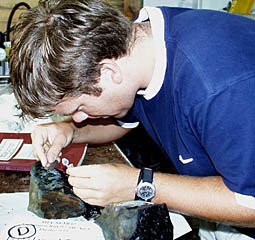|
|
"See the dredge - be the dredge" Imagine you are in a helicopter about 2 miles (3500 meters) above your house. You have a winch in the helicopter that lets you lower a line and a basket to scoop up things that are laying on the ground around your neighborhood. However, clouds block your view, so you have to do this without being able to see where the basket is or where the objects are. You have a map of what’s down there, but you cannot see anything! All you know is the position of the helicopter, your height above the ground, and how much of the line you have let out to drag the basket over the ground. What we’ve just described is what we do to dredge rocks from the seafloor! We've made our detailed maps, our navigation systems are all tuned up, and we have selected seafloor targets. Now, the technique and “art” of dredging come into play. We, together with Ron Comer, are old hands at dredging. With the RV Melville hovering above the seafloor about 3400 meters below, the process begins! First, we lower the heavy dredge with the chain bag over the side of the ship. Then the winch operator lets out about 150 meters of the 9/16 inch diameter steel wire wound on the drum of the winch. Next, we put the pinger on the wire. The pinger is the sound source that “pings” ever second at a frequency 12 kiloHertz so that we can tell when the dredge is on the seafloor. Then the winch operator lowers the dredge to the seafloor and we move the ship slowly along the dredge track. When we dredge, we imagine ourselves on the seafloor, at the mouth of the dredge. Our motto is: “See the dredge, be the dredge”! From experience and the maps that have been made, we know what the seafloor slope is, what kinds of volcanic features are on the ocean floor, and what is the best direction to drag the dredge (usually up the steepest slope). As we pull in and let out the wire to keep the dredge moving across the seafloor, we “feel” the bites that the dredge makes. Bites are what all dredgers like to see -- an increase in the tension on the wire followed by the sudden release of tension when the rocks break free. Hopefully, those rocks end up in the dredge bag! Last night and through this morning, we dredged the seafloor of the Galapagos Rift valley. At two of the volcanoes mapped during our multibeam and DSL-120 sonar surveys, the lava was VERY fresh. Some of the rocks had whitish bacterial slime on them. This is a very important key to looking for newly erupted lava! We know that when there is a volcanic eruption on the seafloor, large amounts of bacteria quickly start growing on the rocks. This is probably in response to the heat of the lava flow, and chemicals that are added to the bottom water from seafloor eruptions and possibly hydrothermal venting. We now need to see more of the seafloor in this area to map out the lava flow and look for hydrothermal activity! To do that, we are towing Argo II about 10 meters above the seafloor at a speed of 0.5 knots. Check back tomorrow for some images and video of the seafloor and see what we've discovered!
|
|||||||||||||||||||||||||||||||||||||||||||||||||||||||||||||||||||||||||||||||||||||||||||||||||||||||||||||||||||||||||||||||||||||||||||||||||||||||||||||||||||
© 2010 Dive and Discover™. Dive and Discover™ is a registered trademark of
Woods
Hole Oceanographic Institution




